Isabella reporting:
Tuesday is the publication day for my new historical romance,
When the Duke Found Love. It's the last of my three-book series featuring the Wylder sisters, all published by Ballantine/Random House. I'll share more about the book tomorrow, but in case you're busily participating in Cyber Monday, you can still add a copy of
When the Duke Found Love to your shopping cart today for delivery at midnight, just like Cinderella herself.
Since I've always written novels set in the past, I'm often asked how I choose the time period. Sometimes I'm inspired by an especially interesting historical event that will determine the setting, and other times it's a certain historical figure that I'd like to feature in my story. But the one constant for me is the clothes. I know it may sound hopelessly shallow, but I have to like the clothes my characters will be wearing, or all bets are off.
When the Duke Found Love is set in London in the 1760s, and yes, the clothes for both the gentlemen and the ladies of that time are quite glorious. There are ruffles and laces galore, silks and jewels and extravagant hats: what's not to love? As an example of the Georgian splendor that I found so inspiring, I'm offering the double portrait,
above, of
Peter Perez Burdett and His First Wife Hannah, by Joseph Wright of Derby. Clearly Mr. Wright enjoyed 18th c. fashion every bit as much as I do, for this painting is filled with stylish detail (click on the image to enlarge.)
While ostensibly out for a country stroll, Mrs. Burdett is dressed to the nines, or maybe the tens: a rich silk gown and petticoat, bow-trimmed bodice, lace-edge pelisse, and fine linen kerchief. Her wide-brimmed straw hat is edged with more lace, and tied with a wide silk ribbon over a lace-trimmed cap. Her sleeve ruffles are truly amazing - see a beautiful close-up detail
here - as are her jeweled bracelet and sunburst earrings.
Her husband is not to be outdone, however. He's wearing a double-breasted striped waistcoat, a velvet coat, and a gold-laced cocked hat, with more stripes knitted into his stockings. Another
close-up shows the wrapped death-head buttons on his coat as well as his heart-shaped
shirt-buckle. (In fact his
shirt and shirt-buckle look very much like those worn by tailor Mark Hutter of
Colonial Williamsburg.)
But while this painting may have inspired my characters' wardrobes, I'm afraid the real-life marriage of Mr. and Mrs. Burdett has no place in a romance. Peter Burdett was a celebrated map-maker and surveyor who made a favorable match by marrying the older Hannah, a wealthy merchant's widow. Joseph Wright was Peter Burdett's friend and likely privy to his true feelings regarding Hannah, so that the emotional distance apparent between the couple in their portrait is probably not accidental. By 1774, Burdett was deeply in debt, and fled England to work in Germany, where he remained for the rest of his life. He took this painting with him – but left the flesh-and-blood Hannah behind to face his creditors.
Above: Peter Perez Burdett and His First Wife Hannah, by Joseph Wright of Derby, 1765. National Gallery of the Czech Republic, Prague.


































 One of us --
One of us -- 


